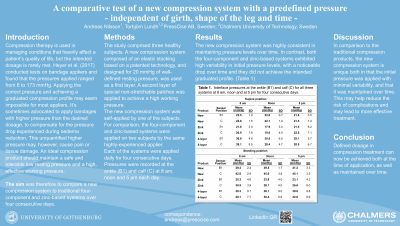Clinical Research
(CR-043) A comparative test of a new compression system with a predefined pressure independent of girth, shape of the leg and time
Friday, April 28, 2023
7:15 PM - 8:30 PM East Coast USA Time

Torbjörn Lundh, PhD, Professor – Chalmers University of Technology, University of Gothenburg
Introduction: Compression therapy is used in managing conditions that heavily affect a patient’s quality of life, but the intended dosage is rarely met. Testing bandage appliers has shown pressures ranging from 6 to 173 mmHg (Heyer et.al., 2017). Applying the correct pressure and achieving a graduated compression profile may seem impossible for most appliers. Furthermore, it’s sometimes advocated to apply bandages with higher pressure than the desired dosage, to compensate for the pressure drop experienced during edema reduction. This unquantified higher pressure may, however, cause pain or tissue damage. An ideal compression product should maintain a safe and tolerable low resting pressure and a high, effective working pressure. The aim was therefore to compare a new compression system to traditional four-component and zinc-based systems over four consecutive days.
Methods: The study comprised three healthy subjects. A new compression system composed of an elastic stocking based on a patented technology, and designed for 20 mmHg of well-defined resting pressure, was used as a first layer. A second layer of special non-stretchable patches was applied to achieve a high working pressure.
The new compression system was self-applied by one of the subjects. For comparison, the four-component and zinc-based systems were applied on two subjects by the same highly-experienced applier.
Each of the systems were applied daily for four consecutive days. Pressures were recorded at the ankle (B1) and calf (C) at 8am, noon and 5pm each day.
Results: The new compression system was consistent in pressure, both in the supine position (Table 1.) and in the standing position. Conversely, the four-component and zinc-based systems showed high variability in initial pressure, pressure drop over time and not the intended graduated pressure profile.
Discussion: In comparison to the traditional compression products, the new compression system is unique both in that the initial pressure was applied with minimal variability, and that it was maintained over time. In conclusion, defined dosage in compression treatment can now be achieved both at the time of application, as well as maintained over time.
Methods: The study comprised three healthy subjects. A new compression system composed of an elastic stocking based on a patented technology, and designed for 20 mmHg of well-defined resting pressure, was used as a first layer. A second layer of special non-stretchable patches was applied to achieve a high working pressure.
The new compression system was self-applied by one of the subjects. For comparison, the four-component and zinc-based systems were applied on two subjects by the same highly-experienced applier.
Each of the systems were applied daily for four consecutive days. Pressures were recorded at the ankle (B1) and calf (C) at 8am, noon and 5pm each day.
Results: The new compression system was consistent in pressure, both in the supine position (Table 1.) and in the standing position. Conversely, the four-component and zinc-based systems showed high variability in initial pressure, pressure drop over time and not the intended graduated pressure profile.
| Product | Sensor Position | 8am | Noon | 5pm |
| New | B1 | 39.3 | 39.5 | 41.2 |
| New | C | 42.8 | 45.0 | 45.1 |
| Zink | B1 | 25.3 | 23.8 | 23.1 |
| Zink | C | 30.5 | 28.1 | 26.6 |
| 4-layer | B1 | 39.3 | 36.1 | 30.8 |
| 4-layer | C | 40.1 | 36.4 | 32.6 |
Discussion: In comparison to the traditional compression products, the new compression system is unique both in that the initial pressure was applied with minimal variability, and that it was maintained over time. In conclusion, defined dosage in compression treatment can now be achieved both at the time of application, as well as maintained over time.

.png)